
Medical device company DexCom (NASDAQ: DXCM) reported Q4 CY2024 results topping the market’s revenue expectations, with sales up 7.6% year on year to $1.11 billion. The company expects the full year’s revenue to be around $4.6 billion, close to analysts’ estimates. Its non-GAAP profit of $0.45 per share was 9.9% below analysts’ consensus estimates.
Is now the time to buy DexCom? Find out by accessing our full research report, it’s free.
DexCom (DXCM) Q4 CY2024 Highlights:
- Revenue: $1.11 billion vs analyst estimates of $1.10 billion (7.6% year-on-year growth, 0.9% beat)
- Adjusted EPS: $0.45 vs analyst expectations of $0.50 (9.9% miss)
- Adjusted EBITDA: $300.1 million vs analyst estimates of $347.6 million (27% margin, 13.7% miss)
- Management’s revenue guidance for the upcoming financial year 2025 is $4.6 billion at the midpoint, in line with analyst expectations and implying 14.1% growth (vs 12.3% in FY2024)
- Operating Margin: 17%, down from 21% in the same quarter last year
- Organic Revenue rose 8% year on year (25.9% in the same quarter last year)
- Market Capitalization: $32.76 billion
Company Overview
Founded in 1999 to address the demand for non-invasive diabetes treatments, DexCom (NASDAQ: DXCM) is a medical technology company known for its glucose monitoring systems for people with diabetes.
Patient Monitoring
Patient monitoring companies within the healthcare equipment industry offer devices and technologies that track chronic conditions and support real-time health management, such as continuous glucose monitors (CGMs) and sleep apnea machines. These businesses benefit from recurring revenue from consumables and software subscriptions tied to device sales (razor, razor blade model). The rising prevalence of chronic diseases like diabetes and respiratory disorders due to an aging population as well as growing adoption of digitization are good for the industry. However, these companies face challenges from high R&D costs and reliance on regulatory approvals. Looking ahead, the sector is positioned for growth due to tailwinds like the rising burden of chronic diseases from an aging population, the shift toward value-based care, and increased adoption of digital health solutions. Innovations in AI and machine learning are expected to enhance device accuracy and functionality, improving patient outcomes and driving demand. However, there are headwinds such as pricing pressures as healthcare costs are a key focus, especially in the US. An evolving regulatory landscape and competition from more tech-forward new entrants could present additional challenges.
Sales Growth
A company’s long-term performance is an indicator of its overall quality. While any business can experience short-term success, top-performing ones enjoy sustained growth for years. Luckily, DexCom’s sales grew at an excellent 22.3% compounded annual growth rate over the last five years. Its growth beat the average healthcare company and shows its offerings resonate with customers, a helpful starting point for our analysis.
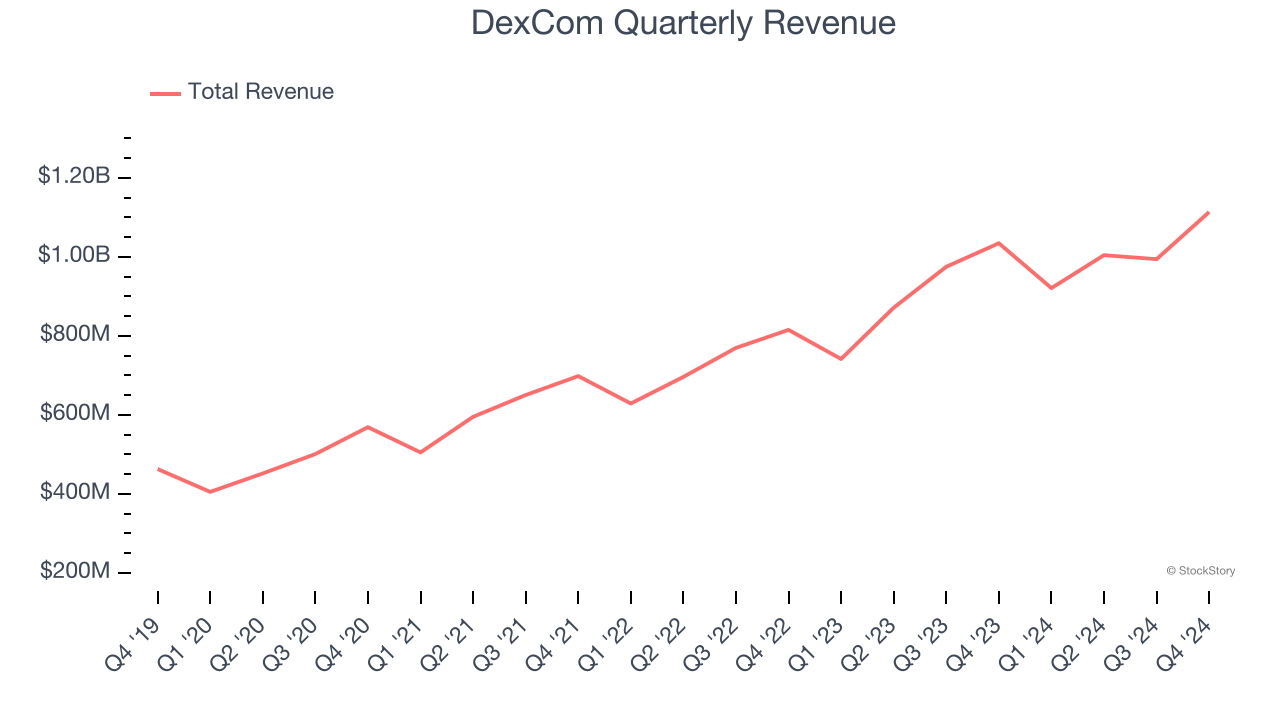
We at StockStory place the most emphasis on long-term growth, but within healthcare, a half-decade historical view may miss recent innovations or disruptive industry trends. DexCom’s annualized revenue growth of 17.7% over the last two years is below its five-year trend, but we still think the results were good and suggest demand was strong. 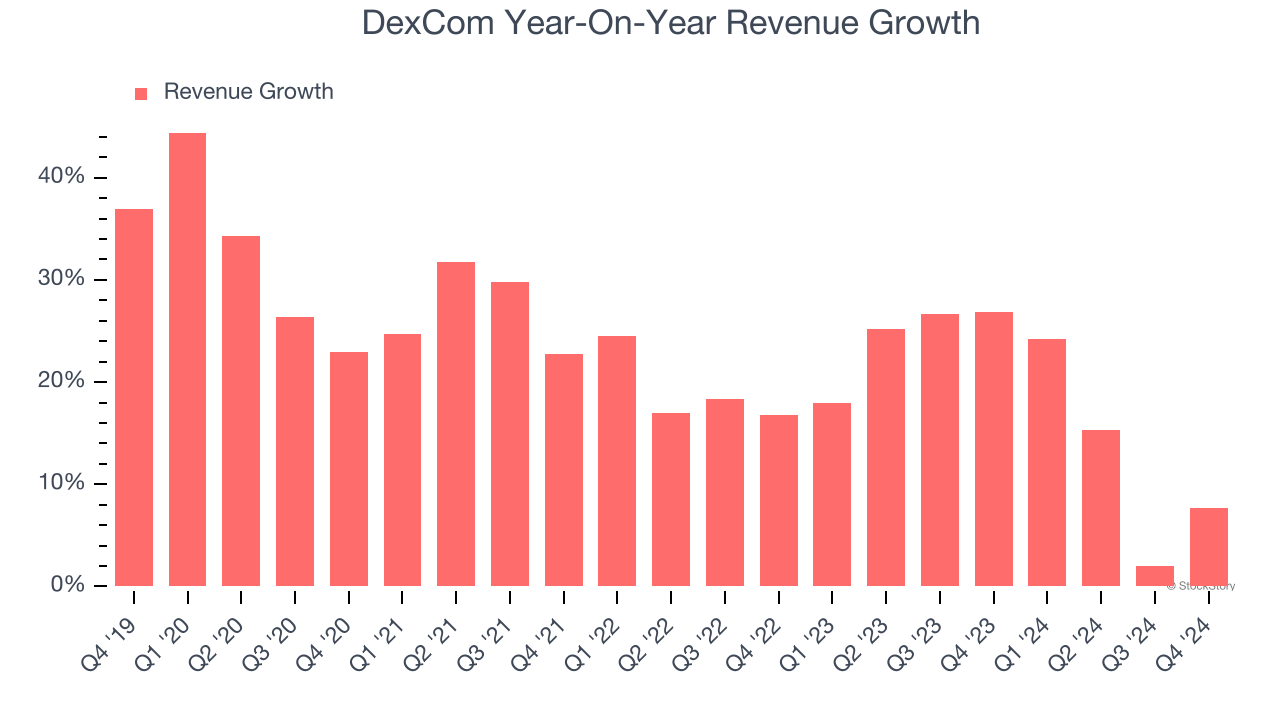
We can dig further into the company’s sales dynamics by analyzing its organic revenue, which strips out one-time events like acquisitions and currency fluctuations that don’t accurately reflect its fundamentals. Over the last two years, DexCom’s organic revenue averaged 18.6% year-on-year growth. Because this number aligns with its normal revenue growth, we can see the company’s core operations (not acquisitions and divestitures) drove most of its results. 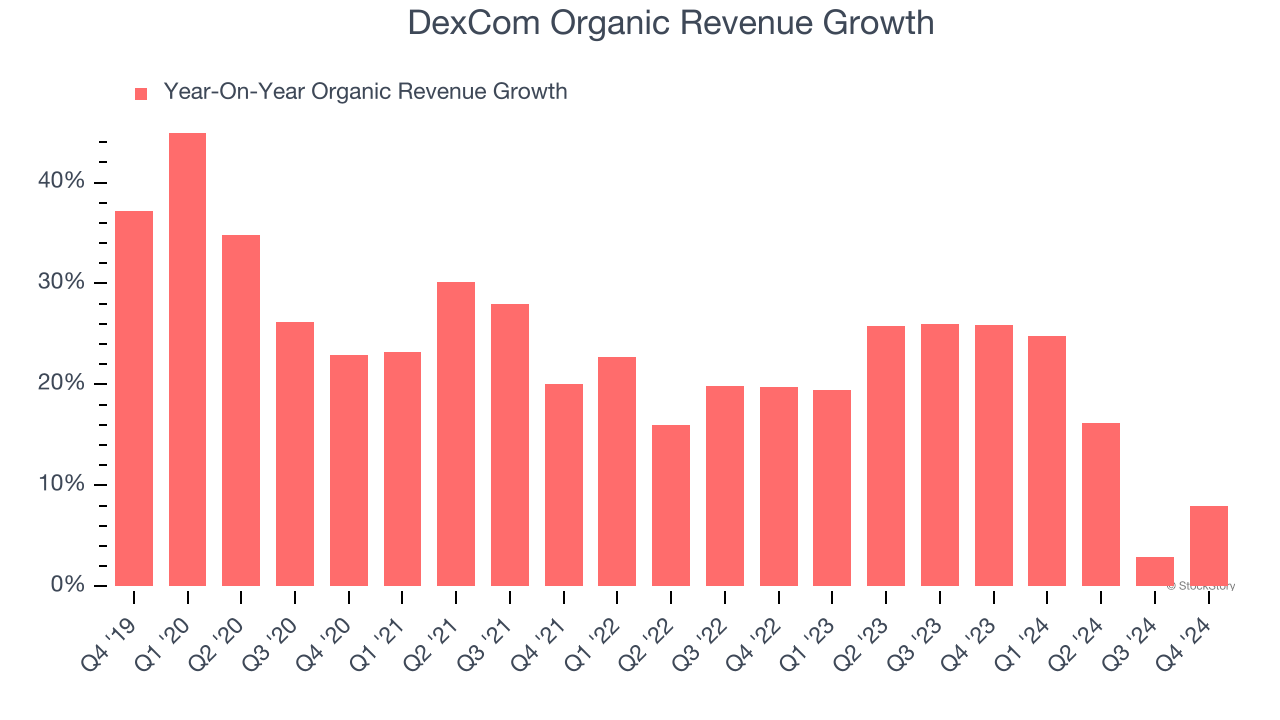
This quarter, DexCom reported year-on-year revenue growth of 7.6%, and its $1.11 billion of revenue exceeded Wall Street’s estimates by 0.9%.
Looking ahead, sell-side analysts expect revenue to grow 14.3% over the next 12 months, a deceleration versus the last two years. Still, this projection is commendable and implies the market is factoring in success for its products and services.
Software is eating the world and there is virtually no industry left that has been untouched by it. That drives increasing demand for tools helping software developers do their jobs, whether it be monitoring critical cloud infrastructure, integrating audio and video functionality, or ensuring smooth content streaming. Click here to access a free report on our 3 favorite stocks to play this generational megatrend.
Operating Margin
DexCom has done a decent job managing its cost base over the last five years. The company has produced an average operating margin of 14.4%, higher than the broader healthcare sector.
Looking at the trend in its profitability, DexCom’s operating margin of 14.9% for the trailing 12 months may be around the same as five years ago, but it has increased by 1.4 percentage points over the last two years. This dynamic unfolded because its sales growth gave it operating leverage and shows it has some momentum on its side.
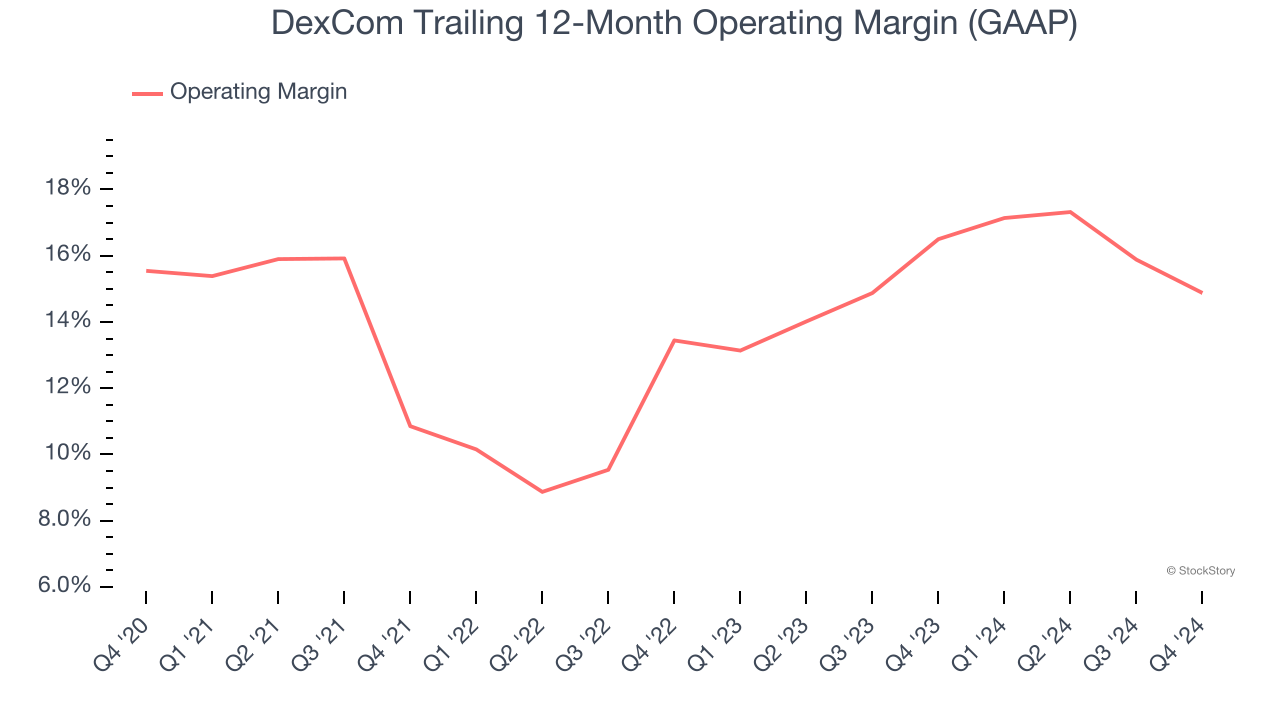
In Q4, DexCom generated an operating profit margin of 17%, down 4 percentage points year on year. This contraction shows it was recently less efficient because its expenses grew faster than its revenue.
Earnings Per Share
We track the long-term change in earnings per share (EPS) for the same reason as long-term revenue growth. Compared to revenue, however, EPS highlights whether a company’s growth is profitable.
DexCom’s EPS grew at an astounding 29% compounded annual growth rate over the last five years, higher than its 22.3% annualized revenue growth. However, we take this with a grain of salt because its operating margin didn’t expand and it didn’t repurchase its shares, meaning the delta came from reduced interest expenses or taxes.
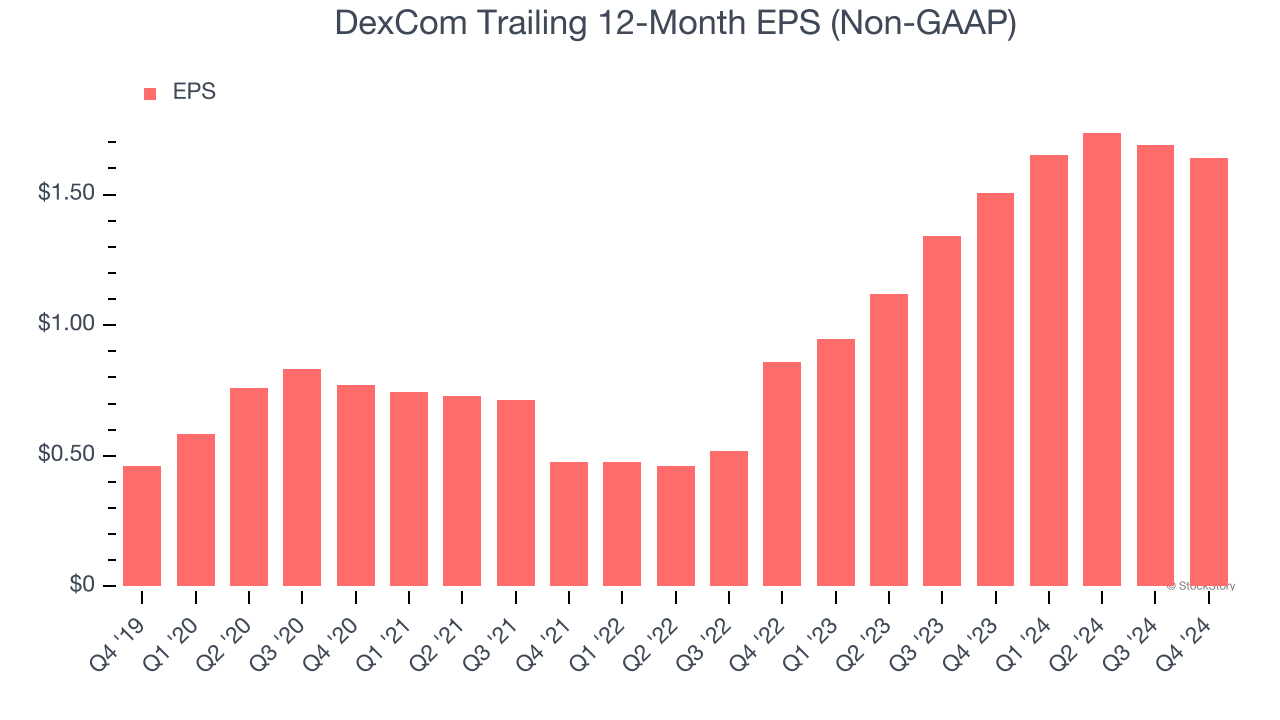
In Q4, DexCom reported EPS at $0.45, down from $0.50 in the same quarter last year. This print missed analysts’ estimates, but we care more about long-term EPS growth than short-term movements. Over the next 12 months, Wall Street expects DexCom’s full-year EPS of $1.64 to grow 23%.
Key Takeaways from DexCom’s Q4 Results
It was good to see DexCom narrowly top analysts’ revenue expectations this quarter despite lower-than-expected organic growth. Full-year revenue guidance was in line with expectations, showing the company is on track. On the other hand, its EPS missed. Overall, this was a mixed quarter. The stock traded up 2.3% to $86.00 immediately following the results.
Is DexCom an attractive investment opportunity at the current price? What happened in the latest quarter matters, but not as much as longer-term business quality and valuation, when deciding whether to invest in this stock. We cover that in our actionable full research report which you can read here, it’s free.






